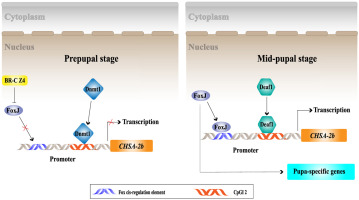当前位置:
X-MOL 学术
›
Insect Biochem. Mol. Biol.
›
论文详情
Our official English website, www.x-mol.net, welcomes your feedback! (Note: you will need to create a separate account there.)
BR-C Z4 and FoxJ interact to regulate expression of a chitin synthase gene CHSA-2b in the pupal wing discs of the silkworm, Bombyx mori.
Insect Biochemistry and Molecular Biology ( IF 3.8 ) Pub Date : 2019-11-07 , DOI: 10.1016/j.ibmb.2019.103264 Jie Zhang 1 , Guanfeng Xu 1 , Binbin Qiu 1 , Xiaojuan Zhang 1 , Qili Feng 1 , Qing Yang 2 , Sichun Zheng 1
Insect Biochemistry and Molecular Biology ( IF 3.8 ) Pub Date : 2019-11-07 , DOI: 10.1016/j.ibmb.2019.103264 Jie Zhang 1 , Guanfeng Xu 1 , Binbin Qiu 1 , Xiaojuan Zhang 1 , Qili Feng 1 , Qing Yang 2 , Sichun Zheng 1
Affiliation

|
Elaborate regulation of tissue- and stage-specific expression of genes is prerequisite for insect development. The hormone 20-hydroxyecdysone (20E) initiates metamorphosis by regulating the expression of a series of genes. However, how 20E orderly regulates the pupa-specific expression of genes remains unclear. In this study, we report a regulatory mechanism for the pupa-specific expression of chitin synthase A 2b (CHSA-2b) in Bombyx mori. We found that Broad-Complex Z4 (BR-C Z4) was up-regulated by 20E just before pupation, while transcription factor FoxJ and CHSA-2b were up-regulated during the pupal stage. There is a Fox cis-regulatory element in the CHSA-2b promoter region, and FoxJ protein bound to this element, enhancing the CHSA-2b transcription during the pupal stage. In addition to CHSA-2b, FoxJ also up-regulated the expression of 16 out of 19 pupa-specific genes tested. However, at the prepupal stage, 20E-induced BR-C Z4 inhibited the FoxJ transcription, indirectly inhibiting the CHSA-2b transcription. These data suggest that at the pre-pupation stage, 20E-induced BR-C Z4 inhibited the expression of pupa-stage genes like CHSA-2b by inhibiting the expression of FoxJ; by the pupal stage, the expression of BR-C Z4 decreased, releasing its inhibition on FoxJ, which then up-regulated the expression of the pupa-specific genes. This study explains the elaborate regulation of the pupa-specific gene expression during metamorphosis in B. mori.
中文翻译:

BR-C Z4和FoxJ相互作用以调节家蚕Bombyx mori的翼盘中几丁质合酶基因CHSA-2b的表达。
精心调节基因的组织和阶段特异性表达是昆虫发育的前提。激素20-羟基蜕皮激素(20E)通过调节一系列基因的表达来引发变态。但是,尚不清楚20E如何有序地调节基因的expression特异性表达。在这项研究中,我们报告了家蚕中几丁质合酶A 2b(CHSA-2b)的pa特异性表达的调控机制。我们发现在化p之前,广泛复合物Z4(BR-C Z4)在20E时被上调,而转录因子FoxJ和CHSA-2b在the化期被上调。在CHSA-2b启动子区域中存在一个Fox顺式调控元件,FoxJ蛋白与该元件结合,从而在the期增强了CHSA-2b的转录。除了CHSA-2b,FoxJ还上调了所测试的19个特异性基因中16个的表达。但是,在pu前阶段,20E诱导的BR-C Z4抑制FoxJ转录,间接抑制CHSA-2b转录。这些数据表明,在化up前期,20E诱导的BR-C Z4通过抑制FoxJ的表达来抑制CH期基因如CHSA-2b的表达。到the期,BR-C Z4的表达下降,释放了对FoxJ的抑制,然后上调了pa特异性基因的表达。这项研究解释了桑蚕变形过程中the特异性基因表达的精细调控。这些数据表明,在化up前期,20E诱导的BR-C Z4通过抑制FoxJ的表达来抑制CH期基因如CHSA-2b的表达。到the期,BR-C Z4的表达下降,释放了对FoxJ的抑制,然后上调了pa特异性基因的表达。这项研究解释了桑蚕变形过程中the特异性基因表达的精细调控。这些数据表明,在化up前期,20E诱导的BR-C Z4通过抑制FoxJ的表达而抑制CH期基因如CHSA-2b的表达。到the期,BR-C Z4的表达下降,释放了对FoxJ的抑制,然后上调了pa特异性基因的表达。这项研究解释了桑蚕变形过程中the特异性基因表达的精细调控。
更新日期:2019-11-07
中文翻译:

BR-C Z4和FoxJ相互作用以调节家蚕Bombyx mori的翼盘中几丁质合酶基因CHSA-2b的表达。
精心调节基因的组织和阶段特异性表达是昆虫发育的前提。激素20-羟基蜕皮激素(20E)通过调节一系列基因的表达来引发变态。但是,尚不清楚20E如何有序地调节基因的expression特异性表达。在这项研究中,我们报告了家蚕中几丁质合酶A 2b(CHSA-2b)的pa特异性表达的调控机制。我们发现在化p之前,广泛复合物Z4(BR-C Z4)在20E时被上调,而转录因子FoxJ和CHSA-2b在the化期被上调。在CHSA-2b启动子区域中存在一个Fox顺式调控元件,FoxJ蛋白与该元件结合,从而在the期增强了CHSA-2b的转录。除了CHSA-2b,FoxJ还上调了所测试的19个特异性基因中16个的表达。但是,在pu前阶段,20E诱导的BR-C Z4抑制FoxJ转录,间接抑制CHSA-2b转录。这些数据表明,在化up前期,20E诱导的BR-C Z4通过抑制FoxJ的表达来抑制CH期基因如CHSA-2b的表达。到the期,BR-C Z4的表达下降,释放了对FoxJ的抑制,然后上调了pa特异性基因的表达。这项研究解释了桑蚕变形过程中the特异性基因表达的精细调控。这些数据表明,在化up前期,20E诱导的BR-C Z4通过抑制FoxJ的表达来抑制CH期基因如CHSA-2b的表达。到the期,BR-C Z4的表达下降,释放了对FoxJ的抑制,然后上调了pa特异性基因的表达。这项研究解释了桑蚕变形过程中the特异性基因表达的精细调控。这些数据表明,在化up前期,20E诱导的BR-C Z4通过抑制FoxJ的表达而抑制CH期基因如CHSA-2b的表达。到the期,BR-C Z4的表达下降,释放了对FoxJ的抑制,然后上调了pa特异性基因的表达。这项研究解释了桑蚕变形过程中the特异性基因表达的精细调控。


























 京公网安备 11010802027423号
京公网安备 11010802027423号